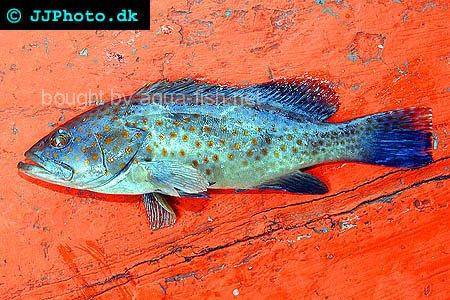Areolate Grouper
This marine aquarium fish is known as Areolate Grouper and the correct latin name is Epinephelus areolatus. It belongs to the Grouper family. (e) Origin of this fish is Indo-West Pacific. (e)
Areolate Grouper can grow up to 40 cm what is approximately 15 inches. So 1 specimen requires at least 4800cm2 of water surface which is approximately 744 square inch. This species will require to be kept in a tank that is large. (e) Medium aquariums have at least 113 Litres (30 US Gallons). Large aquariums have at least 265 Litres (70 US Gallons). Capacity of very large aquariums is at least 700 Litres (185 US Gallons).
It is not very difficult to keep the Areolate Grouper fish. (e) The specific gravity (SG) should be between 1,020 and 1,025, the temperature between 23°C (73.4°F) and 26°C (78.8°F). The pH level should be stable, varying between 8.0 and 8.3 which is usual for marine fish.

Related fish profiles in the database
Feel free to share your experiences regarding keeping Epinephelus areolatus below. Every message will be held for approval by our moderators. It usually takes 24 hours to publish your comment. Before you ask anything, browse the questions page, please.
Character and suggestions regarding care
These fishes are aggressive towards smaller fish.Areolate Grouper can grow up to 40 cm what is approximately 15 inches. So 1 specimen requires at least 4800cm2 of water surface which is approximately 744 square inch. This species will require to be kept in a tank that is large. (e) Medium aquariums have at least 113 Litres (30 US Gallons). Large aquariums have at least 265 Litres (70 US Gallons). Capacity of very large aquariums is at least 700 Litres (185 US Gallons).
It is not very difficult to keep the Areolate Grouper fish. (e) The specific gravity (SG) should be between 1,020 and 1,025, the temperature between 23°C (73.4°F) and 26°C (78.8°F). The pH level should be stable, varying between 8.0 and 8.3 which is usual for marine fish.

Related fish profiles in the database
- Cephalopholis Cyanostigma (Bluespotted Hind)
- Cephalopholis Formosa (Bluelined Hind)
- Cephalopholis Miniata (Miniatus Grouper, Coral Hind)
- Cephalopholis Sexmaculata (Sicblotch Hind)
- Cromileptes Altivelis (Panther Grouper)
- Epinephelus Aeneus (White Grouper)
- Epinephelus Flavocaeruleus (Blue And Yellow Grouper)
- Epinephelus Lanceolatus (Queensland Grouper)
- Epinephelus Marginatus (Dusky Grouper)
- Epinephelus Merra (Honeycomb Grouper)
- Epinephelus Quoyanus (Longfin Grouper)
- Grammistes Sexlineatus (Golden Stripe Soapfish Grouper, Skunk Fish)
- Plectropomus Laevis (Blacksaddled Coralgrouper)
- Plectropomus Maculatus (Spotted Coralgrouper)
- Variola Louti (Yellow-Edged Lyretail)
- Saltwater aquarium heater
- Saltwater aquarium lights
- Saltwater aquarium filters
- Saltwater tank aeration
- Marine fish diseases
- Protein Simmers in the Saltwater Tank
- Setting up a Saltwater Tank
- Saltwater Fish Tanks
- Cleaner Shrimp
- Pajama Cardinals
- Banded Butterflyfish
- Black-Ray Goby
- Blue-Banded Goby
- Blue Chromis
- Blue Green Chromis
- Blue Spot Butterflyfish
- Breeding Seahorses
- Cleaning Goby
- Common Seahorse
- Domino Damselfish
- Dragonface Pipefish
- Drawf Seahorse
- Fire Goby
- Ghost Pipefish
- Golden Damselfish
- Humbug Damselfish
- Lemonpeel Dwarf Angelfish (Centropyge flavissima) Care
- Longfin Bannerfish
- Majestic Angelfish Care
- Neon Velvet Damselfish
- Northern Seahorse
- Pyramid Butterflyfish
- Spotted Watchman Goby
- Tips on Yellow Longnose Butterflyfish Care
- Two Spot Goby
- Yellow Longnose Butterflyfish
Feel free to share your experiences regarding keeping Epinephelus areolatus below. Every message will be held for approval by our moderators. It usually takes 24 hours to publish your comment. Before you ask anything, browse the questions page, please.
Document modified on Mon Dec 10 11:28:31 UTC 2007
Document created on Mon Dec 10 11:28:31 UTC 2007
How to cite this page? Use the following HTML:
edit this page or create a new fish profile "Areolate Grouper." saltwater.aqua-fish.net. Mon Dec 10 11:28:31 UTC 2007.
Aqua-Fish.Net. Fri Jul 18 23:34:18 UTC 2025 https://saltwater.aqua-fish.net/?areolate-grouper.